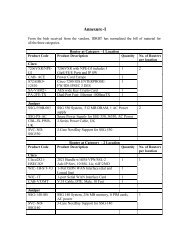New method for feature extraction based on fractal behavior - IDRBT
New method for feature extraction based on fractal behavior - IDRBT
New method for feature extraction based on fractal behavior - IDRBT
You also want an ePaper? Increase the reach of your titles
YUMPU automatically turns print PDFs into web optimized ePapers that Google loves.
Y.Y. Tang et al. / Pattern Recogniti<strong>on</strong> 35 (2002) 1071–1081 1075<br />
Fig. 2. Diagram of <str<strong>on</strong>g>feature</str<strong>on</strong>g> <str<strong>on</strong>g>extracti<strong>on</strong></str<strong>on</strong>g> by wavelet sub-patterns and divider dimensi<strong>on</strong>s <str<strong>on</strong>g>for</str<strong>on</strong>g> the Chinese character “Heart”.<br />
Thus, the expressi<strong>on</strong>s <str<strong>on</strong>g>for</str<strong>on</strong>g> the wavelet trans<str<strong>on</strong>g>for</str<strong>on</strong>g>mati<strong>on</strong> of<br />
V 0 can be written as follows:<br />
5∑<br />
5∑<br />
c j+1;m = h k c j;k+2m ; d j+1;m = g k c j;k+2m (15)<br />
k=0<br />
k=0<br />
where m =0; 1;:::;N − 1.<br />
Hence, the wavelet trans<str<strong>on</strong>g>for</str<strong>on</strong>g>mati<strong>on</strong> sub-patterns of V 0<br />
obtainedusing Eq. (16) will become<br />
V 1 = {c j+1;0 ;c j+1;1 ;:::;c j+1;N−1 };<br />
W 1 = {d j+1;0 ;d j+1;1 ;:::;d j+1;N−1 }: (16)<br />
Step 3. Computati<strong>on</strong> of divider dimensi<strong>on</strong>s <str<strong>on</strong>g>for</str<strong>on</strong>g><br />
wavelet sub-patterns: Since the divider dimensi<strong>on</strong>s of<br />
n<strong>on</strong>-self-intersecting curves are asymptotic values, we<br />
can derive their approximati<strong>on</strong>s <str<strong>on</strong>g>based</str<strong>on</strong>g> <strong>on</strong> the following<br />
expressi<strong>on</strong>:<br />
log M (C)<br />
−log ;<br />
when is set to be small enough. M (C) is the compass<br />
dimensi<strong>on</strong> computed with a ruler of size al<strong>on</strong>g the<br />
curve C.<br />
In our experiments, we per<str<strong>on</strong>g>for</str<strong>on</strong>g>medthree c<strong>on</strong>secutive<br />
wavelet trans<str<strong>on</strong>g>for</str<strong>on</strong>g>mati<strong>on</strong>s <str<strong>on</strong>g>for</str<strong>on</strong>g> each <strong>on</strong>e-dimensi<strong>on</strong>al<br />
pattern. Hence, the <strong>on</strong>e-dimensi<strong>on</strong>al pattern, such as<br />
the central projecti<strong>on</strong> of the Chinese character “Heart”<br />
(Fig. 2), will yieldthree n<strong>on</strong>-self-intersecting curves;<br />
namely: V 0 ;V 1 ;W 1 . By comparing these two frequency<br />
spectra, we can ndthat V 0 c<strong>on</strong>tains all frequency comp<strong>on</strong>ents<br />
of f(x), while V 1 c<strong>on</strong>tains <strong>on</strong>ly <strong>on</strong>e half of the<br />
frequency comp<strong>on</strong>ents of f(x). The reas<strong>on</strong> is that V 0<br />
is divided into two parts: V 0 = V 1 ⊕ W 1 . As <str<strong>on</strong>g>for</str<strong>on</strong>g> the rst<br />
part, V 1 , <strong>on</strong>ly the low-frequency comp<strong>on</strong>ents of V 0 are<br />
kept, andthe high-frequency comp<strong>on</strong>ents are lost. In<br />
additi<strong>on</strong>, <strong>on</strong>ly the high-frequency comp<strong>on</strong>ents of V 0 are<br />
kept, andthe low-frequency comp<strong>on</strong>ents are lost in W 1 .<br />
For each of the three curves, we further computedits<br />
divider dimensi<strong>on</strong>, and there<str<strong>on</strong>g>for</str<strong>on</strong>g>e, related each pattern<br />
with a <str<strong>on</strong>g>feature</str<strong>on</strong>g> vector. These <str<strong>on</strong>g>feature</str<strong>on</strong>g> vectors are presented<br />
as follows:<br />
D vo =1:03911917; D V1 =1:03940148;<br />
D W1 =1:60938780:<br />
These <str<strong>on</strong>g>feature</str<strong>on</strong>g> vectors are selectedto be usedas the<br />
<strong>fractal</strong> <str<strong>on</strong>g>feature</str<strong>on</strong>g> <str<strong>on</strong>g>for</str<strong>on</strong>g> extracting the <str<strong>on</strong>g>feature</str<strong>on</strong>g>s of object. More<br />
details about the central projecti<strong>on</strong> trans<str<strong>on</strong>g>for</str<strong>on</strong>g>mati<strong>on</strong> and<br />
the orth<strong>on</strong>ormal wavelet decompositi<strong>on</strong> can be found in<br />
Ref. [14].<br />
In our experiments, we have testedour new approach<br />
<str<strong>on</strong>g>for</str<strong>on</strong>g> two types of images: 52 upper andlower case printed<br />
alphabets and3000 Chinese characters. We classify<br />
these <str<strong>on</strong>g>feature</str<strong>on</strong>g>s andper<str<strong>on</strong>g>for</str<strong>on</strong>g>m the recogniti<strong>on</strong> of dierent<br />
types of patterns by using the least distance classicati<strong>on</strong><br />
<str<strong>on</strong>g>method</str<strong>on</strong>g>. For each type of the patterns, the center

















